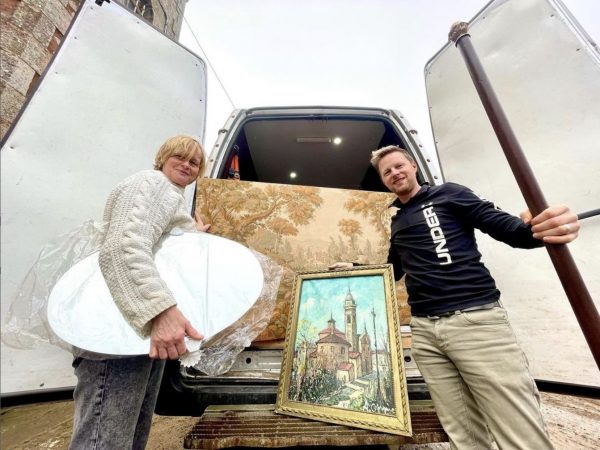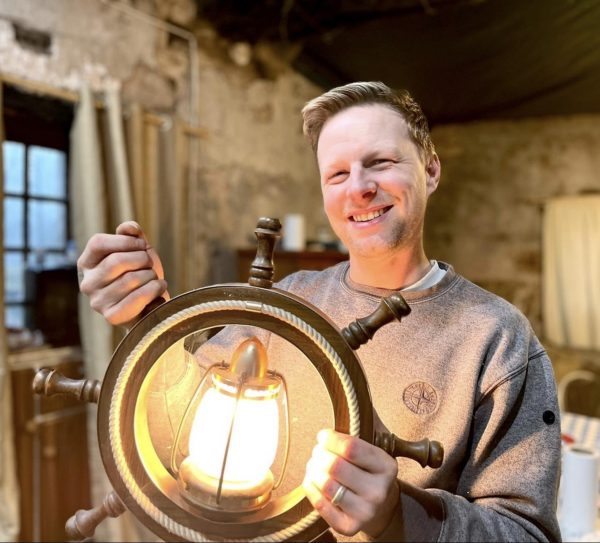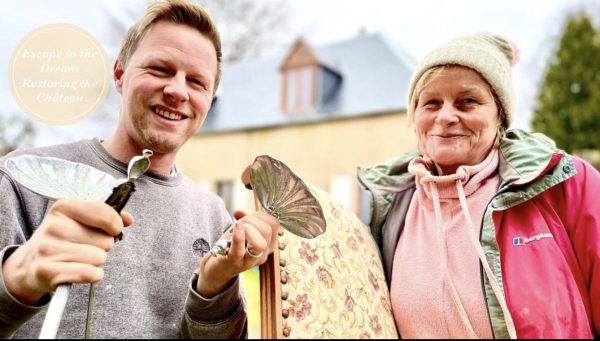What is a Brocante in France?
A brocante is a type of flea market or second-hand store (or sometimes just a VERY full backyard or barn) found in France often with things piled on top of each other. Digging is part of the fun as Terry from Chateau De Lalacelle puts it.
It typically sells a mix of vintage and antique items, including furniture, home decor, collectibles, and even clothing. Brocantes are popular destinations for locals and tourists alike looking for unique and nostalgic pieces.
Terry from Chateau De Lalacelle often finds the perfect pieces for a renovation fix, or something he sees potential in to repair, add, or redo to fit the perfect spot in the Chateau.
How can you find a Brocante in France?
 You might be planning a vacation to France or considering relocating there and might be seeing the benefits of getting a discount or finding a treasure at a brocante.
You might be planning a vacation to France or considering relocating there and might be seeing the benefits of getting a discount or finding a treasure at a brocante.
Brocantes can be found in various locations throughout France. Here are some places to check:
Towns and Villages: Many small towns and villages in France host brocantes, often in public squares, local parks, or along designated streets. These brocantes can offer a charming and intimate setting, allowing you to explore a variety of vintage and antique items. Keep your eyes peeled while driving down highways. There’s often one tucked away in an old farm barn or in the side yard of a residence (with little or no warning).
Cities: Major cities in France, such as Paris, Lyon, Marseille, and Bordeaux, are known for hosting larger-scale brocantes. These cities may have designated brocante districts, permanent brocante stores, or host special brocante events. In cities, brocantes may take place in market halls, shops, exhibition centers, or specific areas designated for flea markets.
Weekend Markets: Many cities and towns across France organize weekend markets that can include a dedicated brocante section. These markets often feature a mix of fresh produce, local products, artisan crafts, and second-hand items. The brocante section of these markets can be a great place to browse and find unique pieces.
Festivals and Fairs: Some festivals and fairs in France also include brocante areas where visitors can explore vintage and antique items amidst the festivities. These events can offer a lively and vibrant atmosphere, blending culture, entertainment, and shopping.
It’s always a good idea to check local tourism offices, newspapers, online travel directories, and community bulletin boards to stay updated on upcoming brocantes in the area you plan to visit. You might even ask a local if you can get by with a bit of French or use a Google Translate app.
Interesting Facts about the culture behind Brocantes in France:
While specific information about the Foire Des Andaines Brocante in Normandy may not be readily available, here are some interesting facts about brocantes in general:
1. Historical Origins: The term “brocante” comes from the French word “broc” meaning old cloth or rags. Originally, brocantes referred to markets where second-hand clothes, accessories and textiles were sold. Over time, the concept expanded to include a wide range of vintage and antique items.
 2. Tradition and Cultural Heritage: Brocantes hold a significant place in French culture and are an integral part of the country’s heritage. They provide an opportunity to preserve and appreciate the history, craftsmanship, and aesthetics of old objects.
2. Tradition and Cultural Heritage: Brocantes hold a significant place in French culture and are an integral part of the country’s heritage. They provide an opportunity to preserve and appreciate the history, craftsmanship, and aesthetics of old objects.
3. Local and Regional Specialties: Different regions in France may have unique brocante specialties. For example, you might find specific types of furniture, pottery, or artwork that are characteristic of a particular area. Exploring brocantes in different regions allows you to discover regional variations in styles and collectibles.
4. Sustainability and Recycling: Brocantes promote sustainable practices by giving new life to pre-loved items. They contribute to reducing waste and provide customers an alternative to buying new, mass-produced products. Embracing brocantes can be a way to support eco-friendly shopping and the circular economy.
5. Treasure Hunting: Brocantes are known for their treasure hunt atmosphere, where you never know what hidden gems or unique finds you might come across. It adds an element of excitement and surprise to the experience, making each brocante visit an adventure.
6. Social and Community Gatherings: Brocantes are not just about shopping but also about socializing and connecting with others who share a passion for antiquities and vintage items. They often create a sense of community, where both buyers and sellers can exchange stories and knowledge about their finds.
Tips for getting the best bargains at a brocante:
Bargaining at a brocante can be a fun and expected part of the experience. Here are some tips to keep in mind when negotiating prices:
1. Do Your Research: Before attending the brocante, research the approximate value of the items you are interested in. This will give you a better idea of their worth and help you determine a reasonable starting point for your negotiations.
2. Start with a Friendly Approach: Approach the vendor with a smile and a friendly greeting. Building a rapport can go a long way in establishing a positive negotiation atmosphere.

3. Inspect the Item: Take a close look at the item you are interested in. Examine its condition, any imperfections, or signs of years of wear. If there are any visible flaws, this can be used as a point of negotiation.
4. Make a Reasonable Offer: Start by offering a price lower than what you are willing to pay, but still within a reasonable range. A good rule of thumb is to start at around 30-40% below the vendor’s asking price, but this can vary depending on the item.
5. Negotiate in Increments: Rather than making a big jump, negotiate in small increments. This allows for a smoother and more amicable bargaining process.
6. Offer Cash: Cash is often preferred at brocantes as it can save the shops a credit car, as it can make negotiations easier. Having the exact amount in smaller bills can be beneficial, as it may make the vendor more willing to agree on a lower price.
7. Bundle Items: If you’re interested in multiple items from the same vendor or shop, consider bundling them together and negotiating a better overall price. This can incentivize the vendor to offer a discount.
8. Be Respectful and Polite: Respect the vendor’s expertise and the value they place on their items. Maintain a polite and professional demeanor throughout the negotiation process, even if an agreement cannot be reached.
9. Use Non-Verbal Cues: Sometimes, a simple nod or hesitant expression can convey that you are not entirely convinced with the offered price. Non-verbal cues can be effective in negotiating a better deal.
10. Know Your Limits: Set a maximum price in your mind that you are willing to pay for an item. If the negotiation exceeds that amount, it may be time to gracefully walk away.
Check out the largest Brocante in Northern France:
From the YouTube Description:
This week at the chateau, the family take a trip to bagnoles de l’orne and visiting the loveliest and largest fairs in Normandy, the yearly Foire Des Andaines features over 2,000 vendors stretching their stalls along a 5 km forest road between Saint Michel des Andaines and Bagnoles de l’Orne.
More about the Foire Des Andaines Brocante
The Foire des Andaines Brocante refers to the brocante fair held in the region of Andaines, which is located in Normandy, France. The Foire des Andaines is an annual event that brings together a wide range of brocanteurs (vendors) offering vintage and antique items for sale.
The fair attracts both locals and visitors who come to browse through the various stalls and discover unique treasures. It is a popular gathering for antique enthusiasts, collectors, and individuals looking for vintage pieces or unique home decor.
In addition to the brocante section, the Foire des Andaines often includes other activities and attractions such as food stalls, live music, entertainment, and games. The fair creates a festive ambiance where people can enjoy the lively atmosphere while exploring the different stalls and finding hidden gems.
The Foire des Andaines Brocante provides an opportunity to immerse yourself in the world of antiques, uncovering the rich history and craftsmanship of various objects. It is worth attending if you have an interest in vintage items, hunting for collectibles, or simply enjoy the vibrant atmosphere of a brocante fair.
Another name for a brocante is Vide Greniers
Vide greniers is a term that translates to “empty attics” or “attic sales” in English. It refers to a type of second-hand market or garage sale (like flea markets) commonly held in France and other French-speaking countries.
 Vide greniers are events, typically organized by individuals, communities, or local associations. They involve many vendors clearing out their attics, garages, or homes to sell various used items, including household goods, clothes, toys, books, furniture, accessories and more.
Vide greniers are events, typically organized by individuals, communities, or local associations. They involve many vendors clearing out their attics, garages, or homes to sell various used items, including household goods, clothes, toys, books, furniture, accessories and more.
It’s a way for vendors to declutter their homes and give a second life to their unwanted possessions and are usually held in public spaces such as streets, squares, or marketplaces.
They are often lively and bustling affairs, especially on weekends or during the summer months. The atmosphere can be festive, with vendors setting up stalls or tables to display their wares, and visitors strolling and searching for interesting finds.
Because of the “event”, this French Flea Market becomes a meeting point where sellers and customers come together to exchange goods, stories, and a sense of shared camaraderie.
Watch as Terry restores a mirror for above the Chateau De Lalacelle Mantel:
